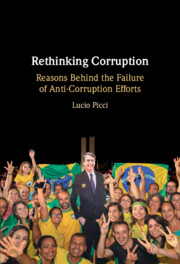Book contents
- Rethinking Corruption
- Rethinking Corruption
- Copyright page
- Dedication
- Contents
- Figures
- Preface
- Part I Laying the Groundwork
- 1 Introduction
- 2 The Consensus on Corruption
- 3 The Mutual Shaping of Measures and Concepts
- 4 Of Causality and Historical Junctures
- 5 What We Talk about When We Talk about Corruption
- Part II Three Case Studies
- Part III Rethinking Corruption
- References
- Index
3 - The Mutual Shaping of Measures and Concepts
from Part I - Laying the Groundwork
Published online by Cambridge University Press: 27 February 2024
- Rethinking Corruption
- Rethinking Corruption
- Copyright page
- Dedication
- Contents
- Figures
- Preface
- Part I Laying the Groundwork
- 1 Introduction
- 2 The Consensus on Corruption
- 3 The Mutual Shaping of Measures and Concepts
- 4 Of Causality and Historical Junctures
- 5 What We Talk about When We Talk about Corruption
- Part II Three Case Studies
- Part III Rethinking Corruption
- References
- Index
Summary
One aspect of the currently prevailing view on corruption is the emphasis on quantifications of corruption, which have been used to research its causes and effects, and to gauge progress of anti-corruption reforms around the world. This chapter is dedicated to these measures. Corruption country scores are an example of so-called Global Performance Indicators and assume that by taking the right initiatives, countries can improve their ranking in a given Global Performance Indicator. However, the available measures of corruption are not well suited to assess changes of corruption over time. A more general conclusion also emerges from this chapter. In studying social phenomena using quantitative techniques of analysis, it is considered to be important to draw a sharp line between the definition of a concept, which should come first, and attempts at measuring it, which should be conditional on the chosen definition. However, when measures of social phenomena are successful, they take on a life of their own and contribute to an ossification of the concept they refer to. Consideration of the extent to which the prevailing concept of corruption and its most popular measures have shaped each other also provides a good angle to discuss corruption more generally.
Keywords
- Type
- Chapter
- Information
- Rethinking CorruptionReasons Behind the Failure of Anti-Corruption Efforts, pp. 32 - 51Publisher: Cambridge University PressPrint publication year: 2024

